Circular Economy: Theoretical Aspects, Benefits, and Dell's Practices
VerifiedAdded on 2019/10/18
|13
|3194
|150
Report
AI Summary
This report delves into the circular economy, a regenerative economic model aimed at eliminating waste and creating value. It explores the concept's characteristics, including technical and biological cycles, and emphasizes its role in minimizing risks and maximizing efficiency. The report highlights the job creation potential within the circular economy, citing studies on employment impacts and the role of innovation. It further examines the economic, business, and societal benefits, such as economic growth, reduced material costs, customer loyalty, and greater utility. The report analyzes Dell's implementation of circular economy practices, including closed-loop recycling and waste reduction initiatives, and assesses the economic, social, and environmental benefits the company achieves. It underscores the importance of a holistic approach and the use of technology for analysis and measurement within the circular economy.
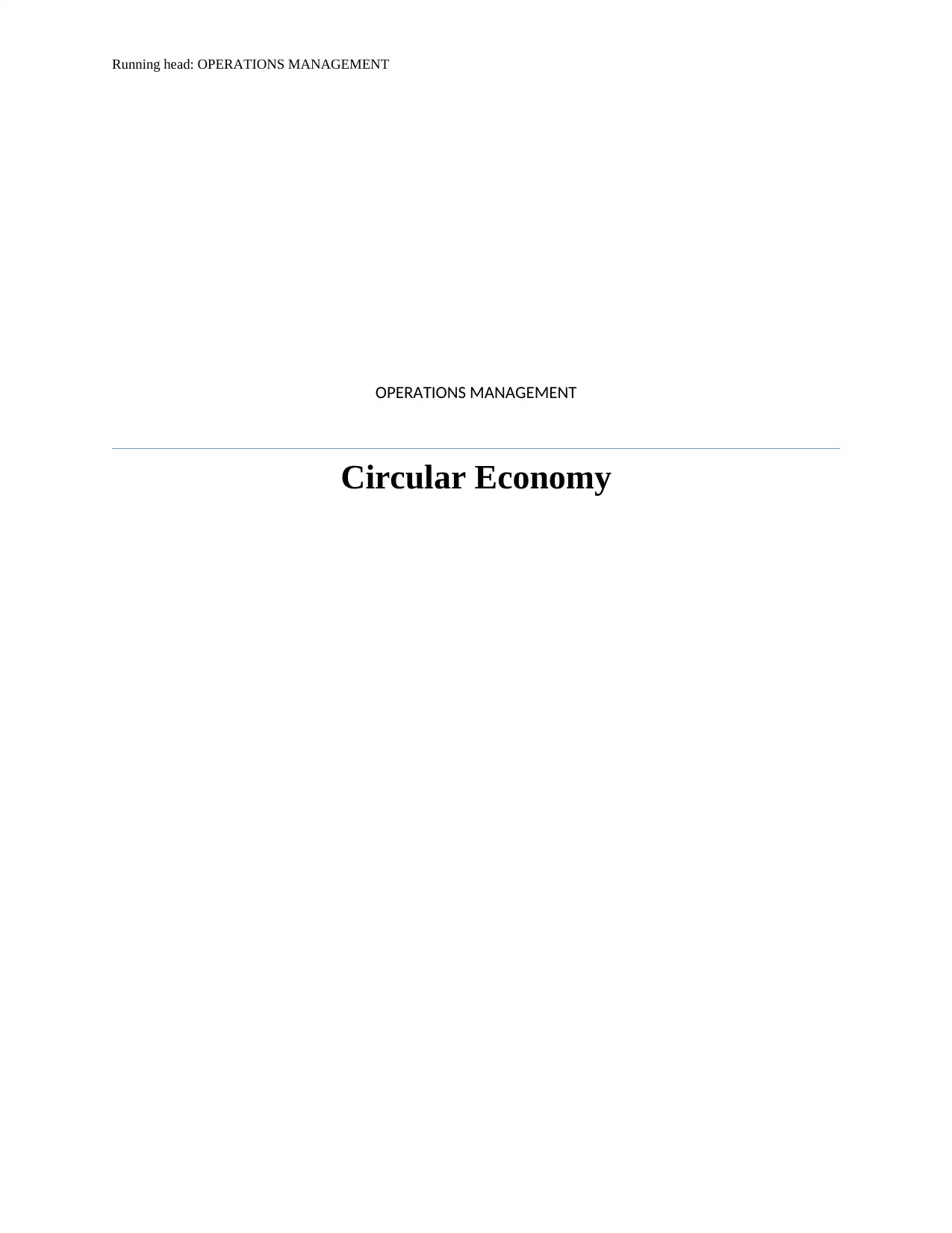
Running head: OPERATIONS MANAGEMENT
OPERATIONS MANAGEMENT
Circular Economy
OPERATIONS MANAGEMENT
Circular Economy
Paraphrase This Document
Need a fresh take? Get an instant paraphrase of this document with our AI Paraphraser
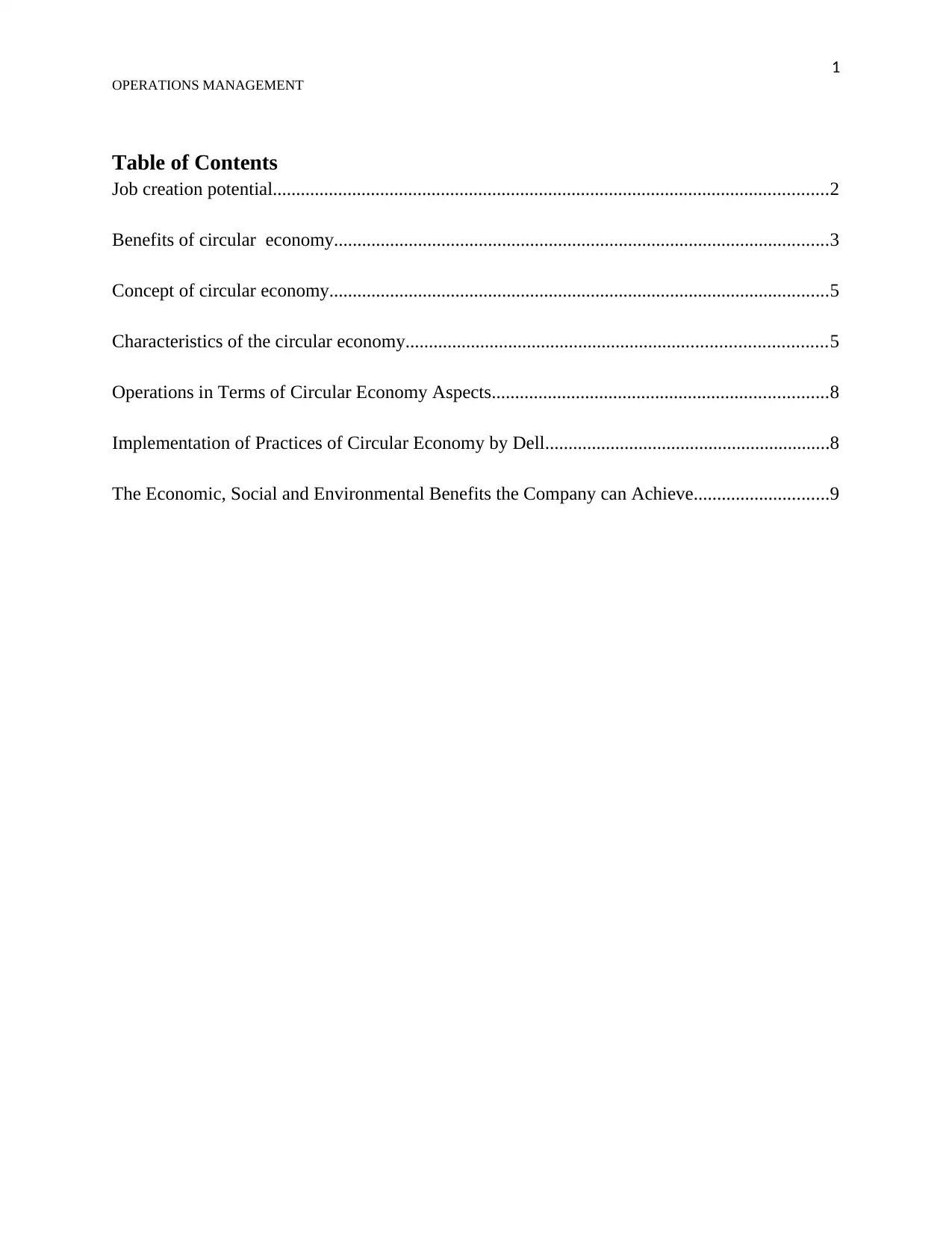
1
OPERATIONS MANAGEMENT
Table of Contents
Job creation potential.......................................................................................................................2
Benefits of circular economy..........................................................................................................3
Concept of circular economy...........................................................................................................5
Characteristics of the circular economy..........................................................................................5
Operations in Terms of Circular Economy Aspects........................................................................8
Implementation of Practices of Circular Economy by Dell.............................................................8
The Economic, Social and Environmental Benefits the Company can Achieve.............................9
OPERATIONS MANAGEMENT
Table of Contents
Job creation potential.......................................................................................................................2
Benefits of circular economy..........................................................................................................3
Concept of circular economy...........................................................................................................5
Characteristics of the circular economy..........................................................................................5
Operations in Terms of Circular Economy Aspects........................................................................8
Implementation of Practices of Circular Economy by Dell.............................................................8
The Economic, Social and Environmental Benefits the Company can Achieve.............................9
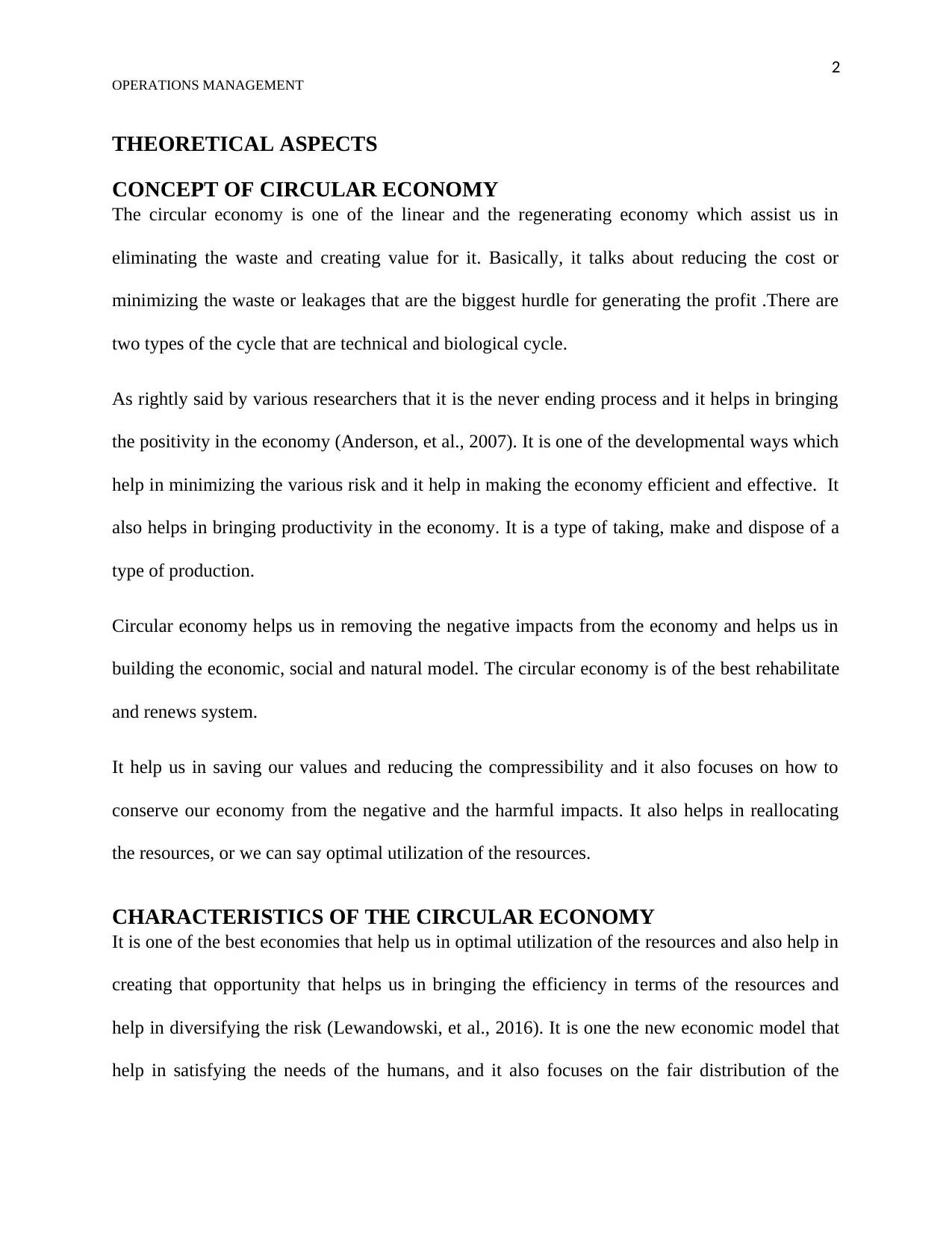
2
OPERATIONS MANAGEMENT
THEORETICAL ASPECTS
CONCEPT OF CIRCULAR ECONOMY
The circular economy is one of the linear and the regenerating economy which assist us in
eliminating the waste and creating value for it. Basically, it talks about reducing the cost or
minimizing the waste or leakages that are the biggest hurdle for generating the profit .There are
two types of the cycle that are technical and biological cycle.
As rightly said by various researchers that it is the never ending process and it helps in bringing
the positivity in the economy (Anderson, et al., 2007). It is one of the developmental ways which
help in minimizing the various risk and it help in making the economy efficient and effective. It
also helps in bringing productivity in the economy. It is a type of taking, make and dispose of a
type of production.
Circular economy helps us in removing the negative impacts from the economy and helps us in
building the economic, social and natural model. The circular economy is of the best rehabilitate
and renews system.
It help us in saving our values and reducing the compressibility and it also focuses on how to
conserve our economy from the negative and the harmful impacts. It also helps in reallocating
the resources, or we can say optimal utilization of the resources.
CHARACTERISTICS OF THE CIRCULAR ECONOMY
It is one of the best economies that help us in optimal utilization of the resources and also help in
creating that opportunity that helps us in bringing the efficiency in terms of the resources and
help in diversifying the risk (Lewandowski, et al., 2016). It is one the new economic model that
help in satisfying the needs of the humans, and it also focuses on the fair distribution of the
OPERATIONS MANAGEMENT
THEORETICAL ASPECTS
CONCEPT OF CIRCULAR ECONOMY
The circular economy is one of the linear and the regenerating economy which assist us in
eliminating the waste and creating value for it. Basically, it talks about reducing the cost or
minimizing the waste or leakages that are the biggest hurdle for generating the profit .There are
two types of the cycle that are technical and biological cycle.
As rightly said by various researchers that it is the never ending process and it helps in bringing
the positivity in the economy (Anderson, et al., 2007). It is one of the developmental ways which
help in minimizing the various risk and it help in making the economy efficient and effective. It
also helps in bringing productivity in the economy. It is a type of taking, make and dispose of a
type of production.
Circular economy helps us in removing the negative impacts from the economy and helps us in
building the economic, social and natural model. The circular economy is of the best rehabilitate
and renews system.
It help us in saving our values and reducing the compressibility and it also focuses on how to
conserve our economy from the negative and the harmful impacts. It also helps in reallocating
the resources, or we can say optimal utilization of the resources.
CHARACTERISTICS OF THE CIRCULAR ECONOMY
It is one of the best economies that help us in optimal utilization of the resources and also help in
creating that opportunity that helps us in bringing the efficiency in terms of the resources and
help in diversifying the risk (Lewandowski, et al., 2016). It is one the new economic model that
help in satisfying the needs of the humans, and it also focuses on the fair distribution of the
⊘ This is a preview!⊘
Do you want full access?
Subscribe today to unlock all pages.

Trusted by 1+ million students worldwide
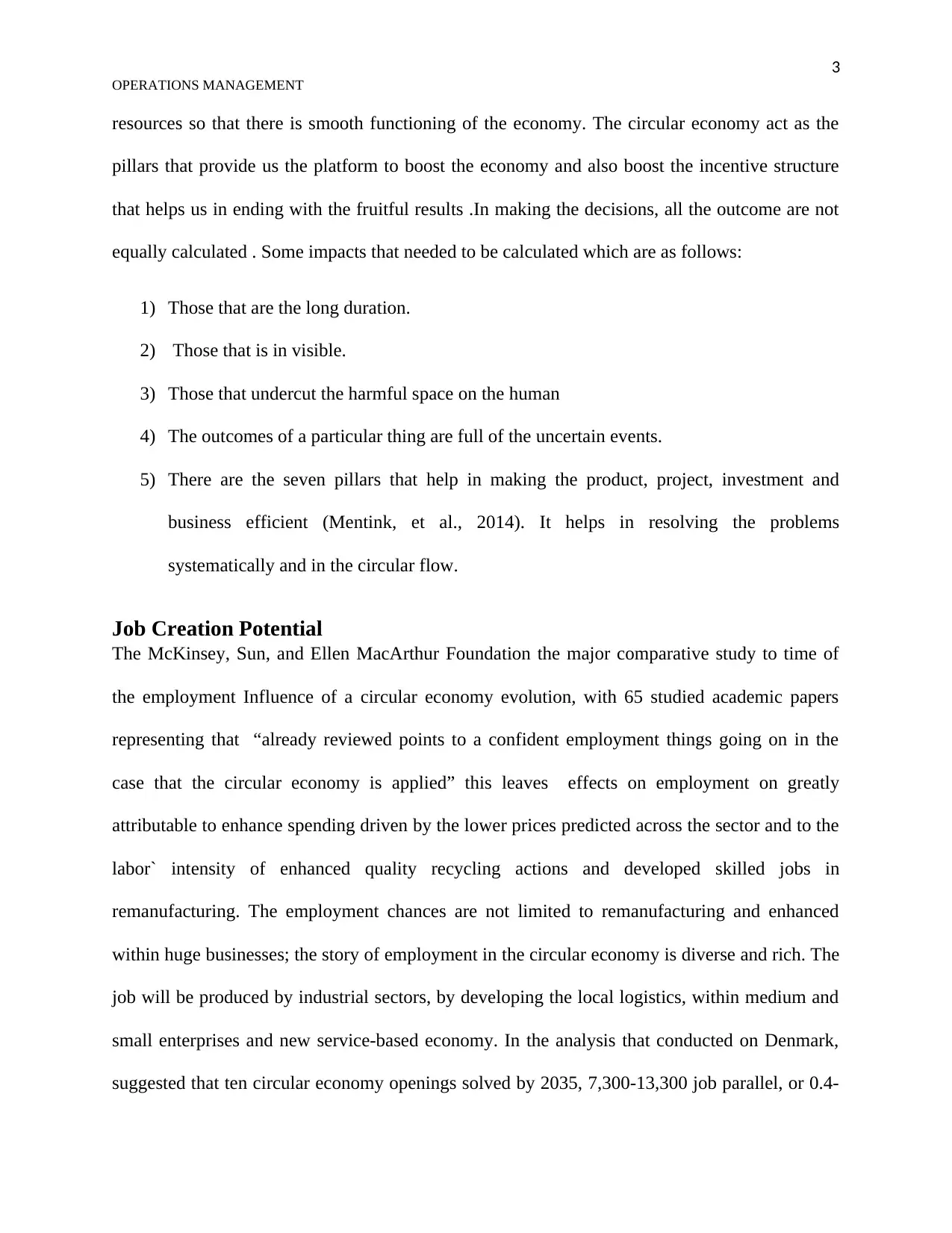
3
OPERATIONS MANAGEMENT
resources so that there is smooth functioning of the economy. The circular economy act as the
pillars that provide us the platform to boost the economy and also boost the incentive structure
that helps us in ending with the fruitful results .In making the decisions, all the outcome are not
equally calculated . Some impacts that needed to be calculated which are as follows:
1) Those that are the long duration.
2) Those that is in visible.
3) Those that undercut the harmful space on the human
4) The outcomes of a particular thing are full of the uncertain events.
5) There are the seven pillars that help in making the product, project, investment and
business efficient (Mentink, et al., 2014). It helps in resolving the problems
systematically and in the circular flow.
Job Creation Potential
The McKinsey, Sun, and Ellen MacArthur Foundation the major comparative study to time of
the employment Influence of a circular economy evolution, with 65 studied academic papers
representing that “already reviewed points to a confident employment things going on in the
case that the circular economy is applied” this leaves effects on employment on greatly
attributable to enhance spending driven by the lower prices predicted across the sector and to the
labor` intensity of enhanced quality recycling actions and developed skilled jobs in
remanufacturing. The employment chances are not limited to remanufacturing and enhanced
within huge businesses; the story of employment in the circular economy is diverse and rich. The
job will be produced by industrial sectors, by developing the local logistics, within medium and
small enterprises and new service-based economy. In the analysis that conducted on Denmark,
suggested that ten circular economy openings solved by 2035, 7,300-13,300 job parallel, or 0.4-
OPERATIONS MANAGEMENT
resources so that there is smooth functioning of the economy. The circular economy act as the
pillars that provide us the platform to boost the economy and also boost the incentive structure
that helps us in ending with the fruitful results .In making the decisions, all the outcome are not
equally calculated . Some impacts that needed to be calculated which are as follows:
1) Those that are the long duration.
2) Those that is in visible.
3) Those that undercut the harmful space on the human
4) The outcomes of a particular thing are full of the uncertain events.
5) There are the seven pillars that help in making the product, project, investment and
business efficient (Mentink, et al., 2014). It helps in resolving the problems
systematically and in the circular flow.
Job Creation Potential
The McKinsey, Sun, and Ellen MacArthur Foundation the major comparative study to time of
the employment Influence of a circular economy evolution, with 65 studied academic papers
representing that “already reviewed points to a confident employment things going on in the
case that the circular economy is applied” this leaves effects on employment on greatly
attributable to enhance spending driven by the lower prices predicted across the sector and to the
labor` intensity of enhanced quality recycling actions and developed skilled jobs in
remanufacturing. The employment chances are not limited to remanufacturing and enhanced
within huge businesses; the story of employment in the circular economy is diverse and rich. The
job will be produced by industrial sectors, by developing the local logistics, within medium and
small enterprises and new service-based economy. In the analysis that conducted on Denmark,
suggested that ten circular economy openings solved by 2035, 7,300-13,300 job parallel, or 0.4-
Paraphrase This Document
Need a fresh take? Get an instant paraphrase of this document with our AI Paraphraser
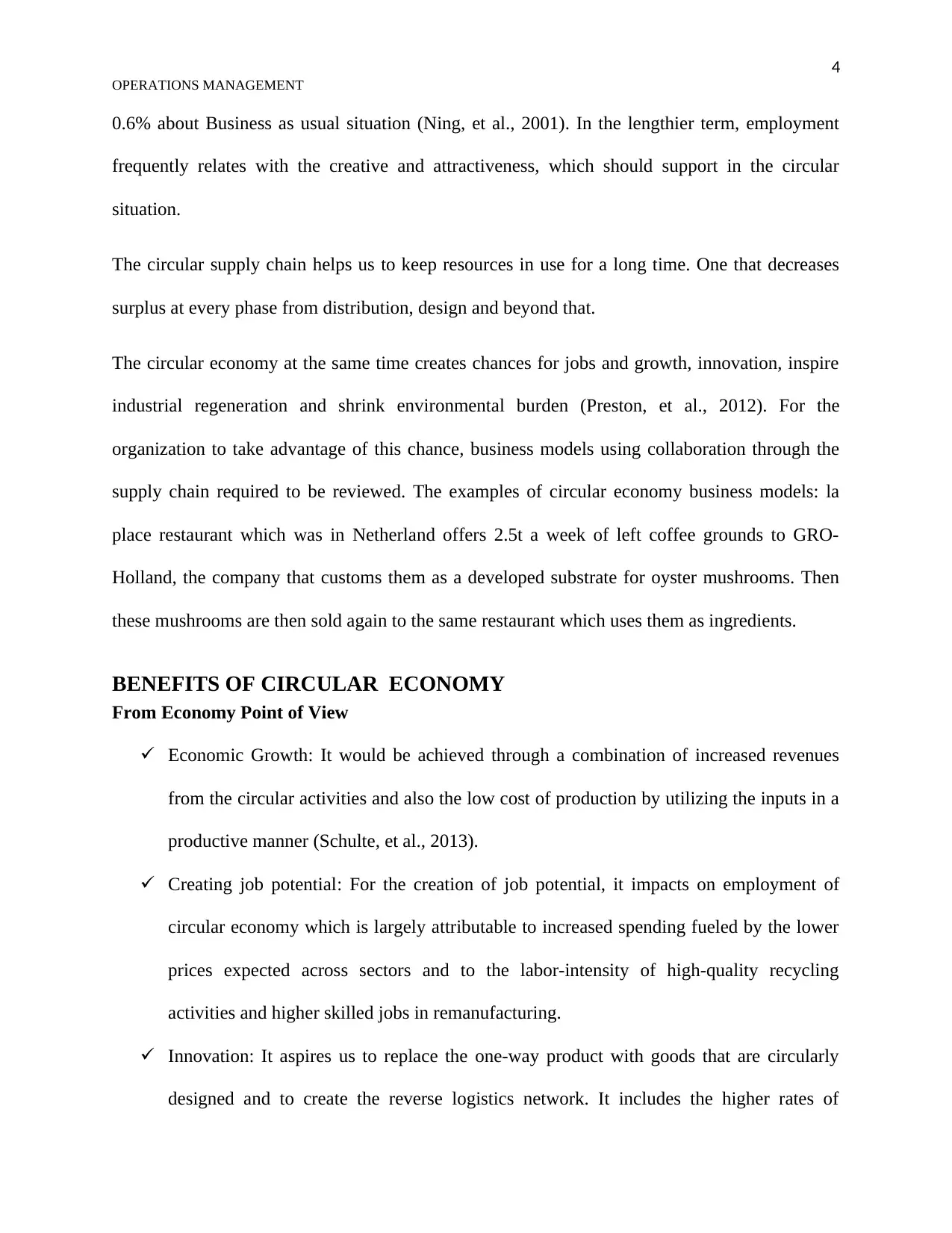
4
OPERATIONS MANAGEMENT
0.6% about Business as usual situation (Ning, et al., 2001). In the lengthier term, employment
frequently relates with the creative and attractiveness, which should support in the circular
situation.
The circular supply chain helps us to keep resources in use for a long time. One that decreases
surplus at every phase from distribution, design and beyond that.
The circular economy at the same time creates chances for jobs and growth, innovation, inspire
industrial regeneration and shrink environmental burden (Preston, et al., 2012). For the
organization to take advantage of this chance, business models using collaboration through the
supply chain required to be reviewed. The examples of circular economy business models: la
place restaurant which was in Netherland offers 2.5t a week of left coffee grounds to GRO-
Holland, the company that customs them as a developed substrate for oyster mushrooms. Then
these mushrooms are then sold again to the same restaurant which uses them as ingredients.
BENEFITS OF CIRCULAR ECONOMY
From Economy Point of View
Economic Growth: It would be achieved through a combination of increased revenues
from the circular activities and also the low cost of production by utilizing the inputs in a
productive manner (Schulte, et al., 2013).
Creating job potential: For the creation of job potential, it impacts on employment of
circular economy which is largely attributable to increased spending fueled by the lower
prices expected across sectors and to the labor-intensity of high-quality recycling
activities and higher skilled jobs in remanufacturing.
Innovation: It aspires us to replace the one-way product with goods that are circularly
designed and to create the reverse logistics network. It includes the higher rates of
OPERATIONS MANAGEMENT
0.6% about Business as usual situation (Ning, et al., 2001). In the lengthier term, employment
frequently relates with the creative and attractiveness, which should support in the circular
situation.
The circular supply chain helps us to keep resources in use for a long time. One that decreases
surplus at every phase from distribution, design and beyond that.
The circular economy at the same time creates chances for jobs and growth, innovation, inspire
industrial regeneration and shrink environmental burden (Preston, et al., 2012). For the
organization to take advantage of this chance, business models using collaboration through the
supply chain required to be reviewed. The examples of circular economy business models: la
place restaurant which was in Netherland offers 2.5t a week of left coffee grounds to GRO-
Holland, the company that customs them as a developed substrate for oyster mushrooms. Then
these mushrooms are then sold again to the same restaurant which uses them as ingredients.
BENEFITS OF CIRCULAR ECONOMY
From Economy Point of View
Economic Growth: It would be achieved through a combination of increased revenues
from the circular activities and also the low cost of production by utilizing the inputs in a
productive manner (Schulte, et al., 2013).
Creating job potential: For the creation of job potential, it impacts on employment of
circular economy which is largely attributable to increased spending fueled by the lower
prices expected across sectors and to the labor-intensity of high-quality recycling
activities and higher skilled jobs in remanufacturing.
Innovation: It aspires us to replace the one-way product with goods that are circularly
designed and to create the reverse logistics network. It includes the higher rates of

5
OPERATIONS MANAGEMENT
technological development, labor and more profit opportunities for the companies benefit
from the economy.
FROM BUSINESS POINT OF VIEW
Reducing the Material cost: A move towards the circular economy help the companies to
reduce the cost of material incurred in the manufacturing which will benefit the
manufacturer by allowing them local access to the raw material needed to manufacture
their goods (Jacobs, et al., 1991).
Top priority to resource scarcity: The resource scarcity will become a top priority to
ensure that the national economies have the resources that they require through end-of-
life resource capture rather than primary raw material excavation.
Helps in boosting employment: It is estimated that in 2025 the Economic Union can
create a net worth of 51,400 in the economy with a further 20,000 potential jobs if they
broadband the target as this is given by the "Friends of Earth."
FROM SOCIETY POINT OF VIEW
Customer interaction and loyalty: Circular economy offers new ways to engage
customers. New business models such as rentals or leasing contracts establish a longer-
term relationship with customers, as the number of touch point’s increase over the
lifetime of a product (Ning, et al., 2001). These business models offer companies the
chance to gain unique insights into usage patterns that can lead to a virtuous circle of
improved products, better service, and greater customer satisfaction.
Greater utility: The utility felt by society may be enhanced by the additional choice or
quality that circular economy provides.
OPERATIONS MANAGEMENT
technological development, labor and more profit opportunities for the companies benefit
from the economy.
FROM BUSINESS POINT OF VIEW
Reducing the Material cost: A move towards the circular economy help the companies to
reduce the cost of material incurred in the manufacturing which will benefit the
manufacturer by allowing them local access to the raw material needed to manufacture
their goods (Jacobs, et al., 1991).
Top priority to resource scarcity: The resource scarcity will become a top priority to
ensure that the national economies have the resources that they require through end-of-
life resource capture rather than primary raw material excavation.
Helps in boosting employment: It is estimated that in 2025 the Economic Union can
create a net worth of 51,400 in the economy with a further 20,000 potential jobs if they
broadband the target as this is given by the "Friends of Earth."
FROM SOCIETY POINT OF VIEW
Customer interaction and loyalty: Circular economy offers new ways to engage
customers. New business models such as rentals or leasing contracts establish a longer-
term relationship with customers, as the number of touch point’s increase over the
lifetime of a product (Ning, et al., 2001). These business models offer companies the
chance to gain unique insights into usage patterns that can lead to a virtuous circle of
improved products, better service, and greater customer satisfaction.
Greater utility: The utility felt by society may be enhanced by the additional choice or
quality that circular economy provides.
⊘ This is a preview!⊘
Do you want full access?
Subscribe today to unlock all pages.

Trusted by 1+ million students worldwide

6
OPERATIONS MANAGEMENT
Reduced obsolescence: It helps to reduce the obsolescence which will improve budgets
and quality of life. For the customer and the society, overcoming premature obsolescence
will significantly bring down total ownership costs and deliver higher convenience since
they would avoid hassles associated with repairs and returns.
Operations in Terms of Circular Economy Aspects
Transforming from customary linear model of business to circular economy model may be
challenging and tough when the company Dell is customized to create and dispose of waste
being part of manufacturing, processes for end customer use and distribution. It involves shift in
culture and also require a high level of planning as well as holistic and aggregate considerations
for whole of the supply chain.
Dell calculates value of circular economy which implements plan for closed loop and involves
various intricate and complex task that require important analysis. The most significant thing to
understand the circular economy is that only systems ae take into consideration and not the
initiatives, programs or products (Solow, et al., 1993). Looking at aggregate system involves
change that makes a big difference. Technology can be considered as a best tool to analyze and
measure the systems, understand the process and identify the inefficiencies.
PRACTICAL ASPECTS
Implementation of Practices of Circular Economy by Dell
Dell takes the role of an advocate to share the potential solutions of circular economy with
companies that surround the world. By recognizing new partnerships, creating new approaches
and sharing experiences, Dell is helping to circular economy to get flourished on global basis.
Key factor of circular economy involves that it is regarding an economy. There is an important
potential for the company to lower cost and open opportunities for new market by efficiently
OPERATIONS MANAGEMENT
Reduced obsolescence: It helps to reduce the obsolescence which will improve budgets
and quality of life. For the customer and the society, overcoming premature obsolescence
will significantly bring down total ownership costs and deliver higher convenience since
they would avoid hassles associated with repairs and returns.
Operations in Terms of Circular Economy Aspects
Transforming from customary linear model of business to circular economy model may be
challenging and tough when the company Dell is customized to create and dispose of waste
being part of manufacturing, processes for end customer use and distribution. It involves shift in
culture and also require a high level of planning as well as holistic and aggregate considerations
for whole of the supply chain.
Dell calculates value of circular economy which implements plan for closed loop and involves
various intricate and complex task that require important analysis. The most significant thing to
understand the circular economy is that only systems ae take into consideration and not the
initiatives, programs or products (Solow, et al., 1993). Looking at aggregate system involves
change that makes a big difference. Technology can be considered as a best tool to analyze and
measure the systems, understand the process and identify the inefficiencies.
PRACTICAL ASPECTS
Implementation of Practices of Circular Economy by Dell
Dell takes the role of an advocate to share the potential solutions of circular economy with
companies that surround the world. By recognizing new partnerships, creating new approaches
and sharing experiences, Dell is helping to circular economy to get flourished on global basis.
Key factor of circular economy involves that it is regarding an economy. There is an important
potential for the company to lower cost and open opportunities for new market by efficiently
Paraphrase This Document
Need a fresh take? Get an instant paraphrase of this document with our AI Paraphraser
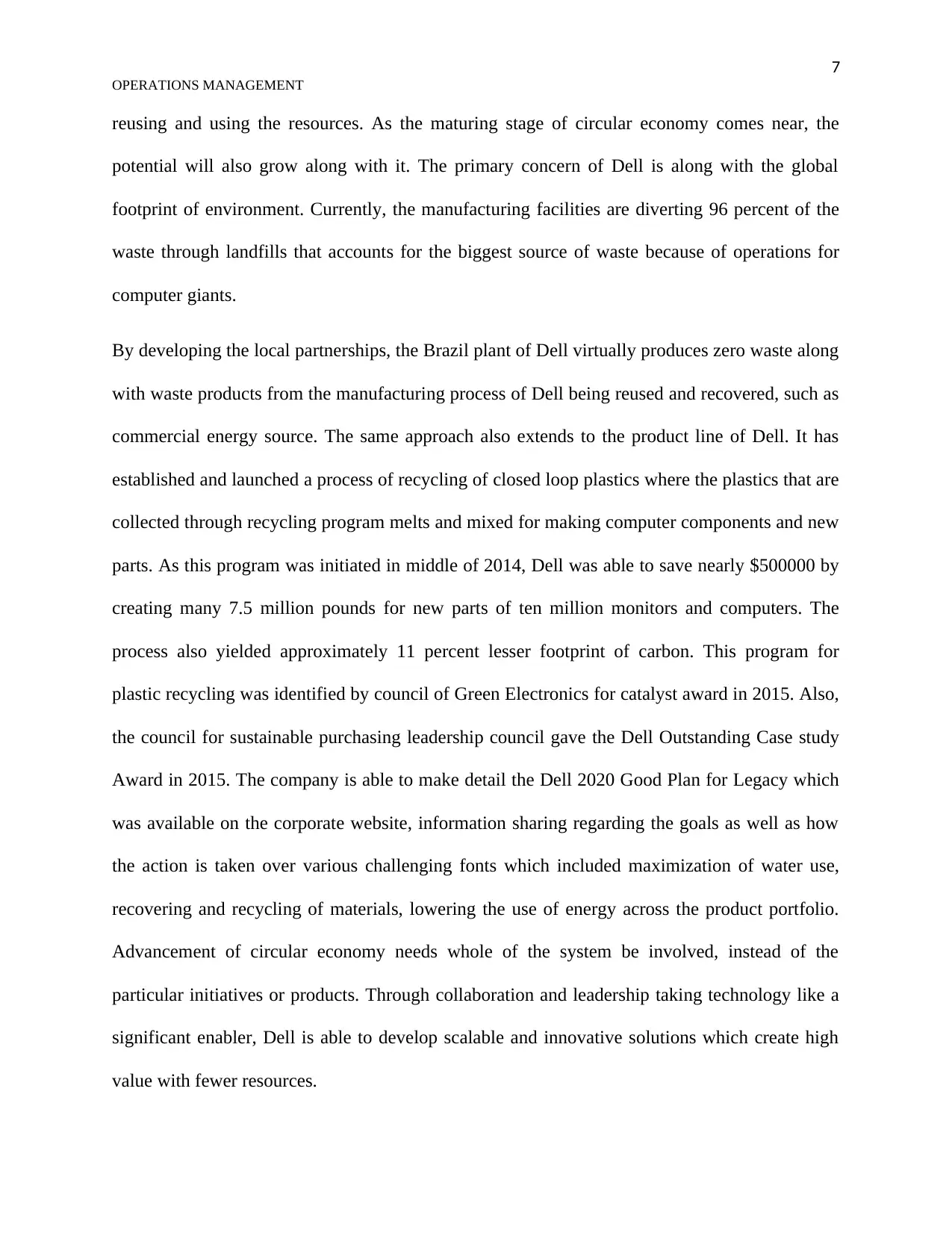
7
OPERATIONS MANAGEMENT
reusing and using the resources. As the maturing stage of circular economy comes near, the
potential will also grow along with it. The primary concern of Dell is along with the global
footprint of environment. Currently, the manufacturing facilities are diverting 96 percent of the
waste through landfills that accounts for the biggest source of waste because of operations for
computer giants.
By developing the local partnerships, the Brazil plant of Dell virtually produces zero waste along
with waste products from the manufacturing process of Dell being reused and recovered, such as
commercial energy source. The same approach also extends to the product line of Dell. It has
established and launched a process of recycling of closed loop plastics where the plastics that are
collected through recycling program melts and mixed for making computer components and new
parts. As this program was initiated in middle of 2014, Dell was able to save nearly $500000 by
creating many 7.5 million pounds for new parts of ten million monitors and computers. The
process also yielded approximately 11 percent lesser footprint of carbon. This program for
plastic recycling was identified by council of Green Electronics for catalyst award in 2015. Also,
the council for sustainable purchasing leadership council gave the Dell Outstanding Case study
Award in 2015. The company is able to make detail the Dell 2020 Good Plan for Legacy which
was available on the corporate website, information sharing regarding the goals as well as how
the action is taken over various challenging fonts which included maximization of water use,
recovering and recycling of materials, lowering the use of energy across the product portfolio.
Advancement of circular economy needs whole of the system be involved, instead of the
particular initiatives or products. Through collaboration and leadership taking technology like a
significant enabler, Dell is able to develop scalable and innovative solutions which create high
value with fewer resources.
OPERATIONS MANAGEMENT
reusing and using the resources. As the maturing stage of circular economy comes near, the
potential will also grow along with it. The primary concern of Dell is along with the global
footprint of environment. Currently, the manufacturing facilities are diverting 96 percent of the
waste through landfills that accounts for the biggest source of waste because of operations for
computer giants.
By developing the local partnerships, the Brazil plant of Dell virtually produces zero waste along
with waste products from the manufacturing process of Dell being reused and recovered, such as
commercial energy source. The same approach also extends to the product line of Dell. It has
established and launched a process of recycling of closed loop plastics where the plastics that are
collected through recycling program melts and mixed for making computer components and new
parts. As this program was initiated in middle of 2014, Dell was able to save nearly $500000 by
creating many 7.5 million pounds for new parts of ten million monitors and computers. The
process also yielded approximately 11 percent lesser footprint of carbon. This program for
plastic recycling was identified by council of Green Electronics for catalyst award in 2015. Also,
the council for sustainable purchasing leadership council gave the Dell Outstanding Case study
Award in 2015. The company is able to make detail the Dell 2020 Good Plan for Legacy which
was available on the corporate website, information sharing regarding the goals as well as how
the action is taken over various challenging fonts which included maximization of water use,
recovering and recycling of materials, lowering the use of energy across the product portfolio.
Advancement of circular economy needs whole of the system be involved, instead of the
particular initiatives or products. Through collaboration and leadership taking technology like a
significant enabler, Dell is able to develop scalable and innovative solutions which create high
value with fewer resources.
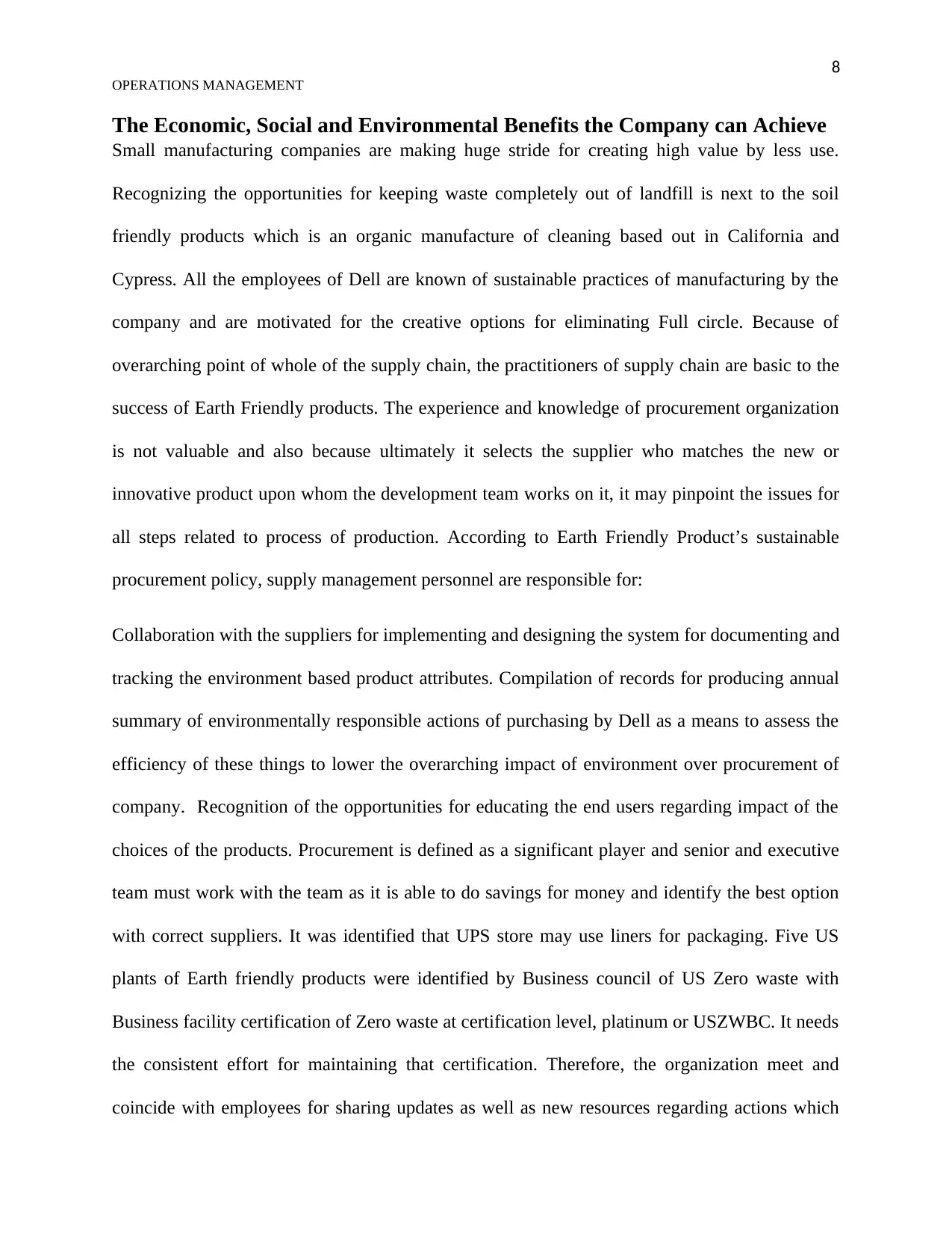
8
OPERATIONS MANAGEMENT
The Economic, Social and Environmental Benefits the Company can Achieve
Small manufacturing companies are making huge stride for creating high value by less use.
Recognizing the opportunities for keeping waste completely out of landfill is next to the soil
friendly products which is an organic manufacture of cleaning based out in California and
Cypress. All the employees of Dell are known of sustainable practices of manufacturing by the
company and are motivated for the creative options for eliminating Full circle. Because of
overarching point of whole of the supply chain, the practitioners of supply chain are basic to the
success of Earth Friendly products. The experience and knowledge of procurement organization
is not valuable and also because ultimately it selects the supplier who matches the new or
innovative product upon whom the development team works on it, it may pinpoint the issues for
all steps related to process of production. According to Earth Friendly Product’s sustainable
procurement policy, supply management personnel are responsible for:
Collaboration with the suppliers for implementing and designing the system for documenting and
tracking the environment based product attributes. Compilation of records for producing annual
summary of environmentally responsible actions of purchasing by Dell as a means to assess the
efficiency of these things to lower the overarching impact of environment over procurement of
company. Recognition of the opportunities for educating the end users regarding impact of the
choices of the products. Procurement is defined as a significant player and senior and executive
team must work with the team as it is able to do savings for money and identify the best option
with correct suppliers. It was identified that UPS store may use liners for packaging. Five US
plants of Earth friendly products were identified by Business council of US Zero waste with
Business facility certification of Zero waste at certification level, platinum or USZWBC. It needs
the consistent effort for maintaining that certification. Therefore, the organization meet and
coincide with employees for sharing updates as well as new resources regarding actions which
OPERATIONS MANAGEMENT
The Economic, Social and Environmental Benefits the Company can Achieve
Small manufacturing companies are making huge stride for creating high value by less use.
Recognizing the opportunities for keeping waste completely out of landfill is next to the soil
friendly products which is an organic manufacture of cleaning based out in California and
Cypress. All the employees of Dell are known of sustainable practices of manufacturing by the
company and are motivated for the creative options for eliminating Full circle. Because of
overarching point of whole of the supply chain, the practitioners of supply chain are basic to the
success of Earth Friendly products. The experience and knowledge of procurement organization
is not valuable and also because ultimately it selects the supplier who matches the new or
innovative product upon whom the development team works on it, it may pinpoint the issues for
all steps related to process of production. According to Earth Friendly Product’s sustainable
procurement policy, supply management personnel are responsible for:
Collaboration with the suppliers for implementing and designing the system for documenting and
tracking the environment based product attributes. Compilation of records for producing annual
summary of environmentally responsible actions of purchasing by Dell as a means to assess the
efficiency of these things to lower the overarching impact of environment over procurement of
company. Recognition of the opportunities for educating the end users regarding impact of the
choices of the products. Procurement is defined as a significant player and senior and executive
team must work with the team as it is able to do savings for money and identify the best option
with correct suppliers. It was identified that UPS store may use liners for packaging. Five US
plants of Earth friendly products were identified by Business council of US Zero waste with
Business facility certification of Zero waste at certification level, platinum or USZWBC. It needs
the consistent effort for maintaining that certification. Therefore, the organization meet and
coincide with employees for sharing updates as well as new resources regarding actions which
⊘ This is a preview!⊘
Do you want full access?
Subscribe today to unlock all pages.

Trusted by 1+ million students worldwide

9
OPERATIONS MANAGEMENT
give contribution to zero waste bottom line. The company is also going to launch the incentive
program along with scorecard for keeping the employees motivated. The suppliers sharing the
similar mindsets are called as the valuable players in company role in the circular economy. The
suppliers which are committed for sustainability of environment maintain the relationships on
foundation of collaboration and trust. Working in collaboration with significant suppliers over
issues of sustainability that starts with vision that is shared. We need to help the suppliers to
embrace the opportunities for improving and innovating performance. Dell hosts various training
sessions and supplier workshops every year for addressing the issues like accounting for
greenhouse gas, evaluation tools of corporate responsibility performance and for reporting the
data to supply chain program of carbon disclosure project. These events serve like opportunities
of networking. Dell happens to conduct the sessions that are innovative with the suppliers for
challenging the traditional ways to explore and think about opportunities for new product. The
company takes the tracking of performance and communication seriously only when making use
of third party/external reporting, by asking the suppliers for being transparent along with
initiatives of sustainability (Witjes, et al., 2016).
Company’s Supply Chain supports the Business Operations
Supply chain management has become the most essential activity in a company which
implements a circular business model.
Circular economy is all about recycling or reusing the products from their end stage of life cycle
in value chain. It is creating unending loops, where finished goods are used as raw material.
The objective of supply chain management is to provide a use of end products in a creative way
which gives more value to companies. This can be done by tie up with different companies and
use their waste product in a different process.
OPERATIONS MANAGEMENT
give contribution to zero waste bottom line. The company is also going to launch the incentive
program along with scorecard for keeping the employees motivated. The suppliers sharing the
similar mindsets are called as the valuable players in company role in the circular economy. The
suppliers which are committed for sustainability of environment maintain the relationships on
foundation of collaboration and trust. Working in collaboration with significant suppliers over
issues of sustainability that starts with vision that is shared. We need to help the suppliers to
embrace the opportunities for improving and innovating performance. Dell hosts various training
sessions and supplier workshops every year for addressing the issues like accounting for
greenhouse gas, evaluation tools of corporate responsibility performance and for reporting the
data to supply chain program of carbon disclosure project. These events serve like opportunities
of networking. Dell happens to conduct the sessions that are innovative with the suppliers for
challenging the traditional ways to explore and think about opportunities for new product. The
company takes the tracking of performance and communication seriously only when making use
of third party/external reporting, by asking the suppliers for being transparent along with
initiatives of sustainability (Witjes, et al., 2016).
Company’s Supply Chain supports the Business Operations
Supply chain management has become the most essential activity in a company which
implements a circular business model.
Circular economy is all about recycling or reusing the products from their end stage of life cycle
in value chain. It is creating unending loops, where finished goods are used as raw material.
The objective of supply chain management is to provide a use of end products in a creative way
which gives more value to companies. This can be done by tie up with different companies and
use their waste product in a different process.
Paraphrase This Document
Need a fresh take? Get an instant paraphrase of this document with our AI Paraphraser
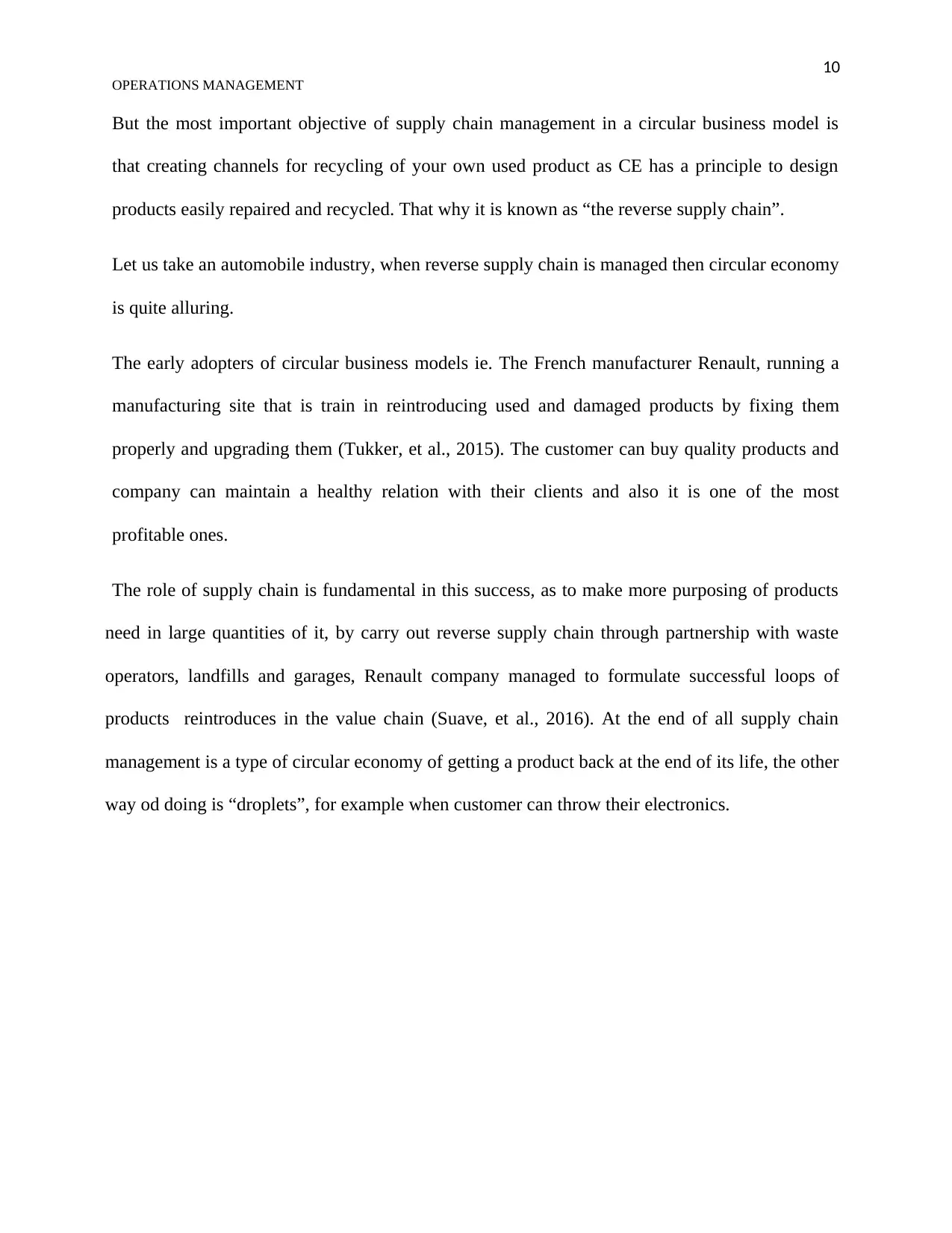
10
OPERATIONS MANAGEMENT
But the most important objective of supply chain management in a circular business model is
that creating channels for recycling of your own used product as CE has a principle to design
products easily repaired and recycled. That why it is known as “the reverse supply chain”.
Let us take an automobile industry, when reverse supply chain is managed then circular economy
is quite alluring.
The early adopters of circular business models ie. The French manufacturer Renault, running a
manufacturing site that is train in reintroducing used and damaged products by fixing them
properly and upgrading them (Tukker, et al., 2015). The customer can buy quality products and
company can maintain a healthy relation with their clients and also it is one of the most
profitable ones.
The role of supply chain is fundamental in this success, as to make more purposing of products
need in large quantities of it, by carry out reverse supply chain through partnership with waste
operators, landfills and garages, Renault company managed to formulate successful loops of
products reintroduces in the value chain (Suave, et al., 2016). At the end of all supply chain
management is a type of circular economy of getting a product back at the end of its life, the other
way od doing is “droplets”, for example when customer can throw their electronics.
OPERATIONS MANAGEMENT
But the most important objective of supply chain management in a circular business model is
that creating channels for recycling of your own used product as CE has a principle to design
products easily repaired and recycled. That why it is known as “the reverse supply chain”.
Let us take an automobile industry, when reverse supply chain is managed then circular economy
is quite alluring.
The early adopters of circular business models ie. The French manufacturer Renault, running a
manufacturing site that is train in reintroducing used and damaged products by fixing them
properly and upgrading them (Tukker, et al., 2015). The customer can buy quality products and
company can maintain a healthy relation with their clients and also it is one of the most
profitable ones.
The role of supply chain is fundamental in this success, as to make more purposing of products
need in large quantities of it, by carry out reverse supply chain through partnership with waste
operators, landfills and garages, Renault company managed to formulate successful loops of
products reintroduces in the value chain (Suave, et al., 2016). At the end of all supply chain
management is a type of circular economy of getting a product back at the end of its life, the other
way od doing is “droplets”, for example when customer can throw their electronics.
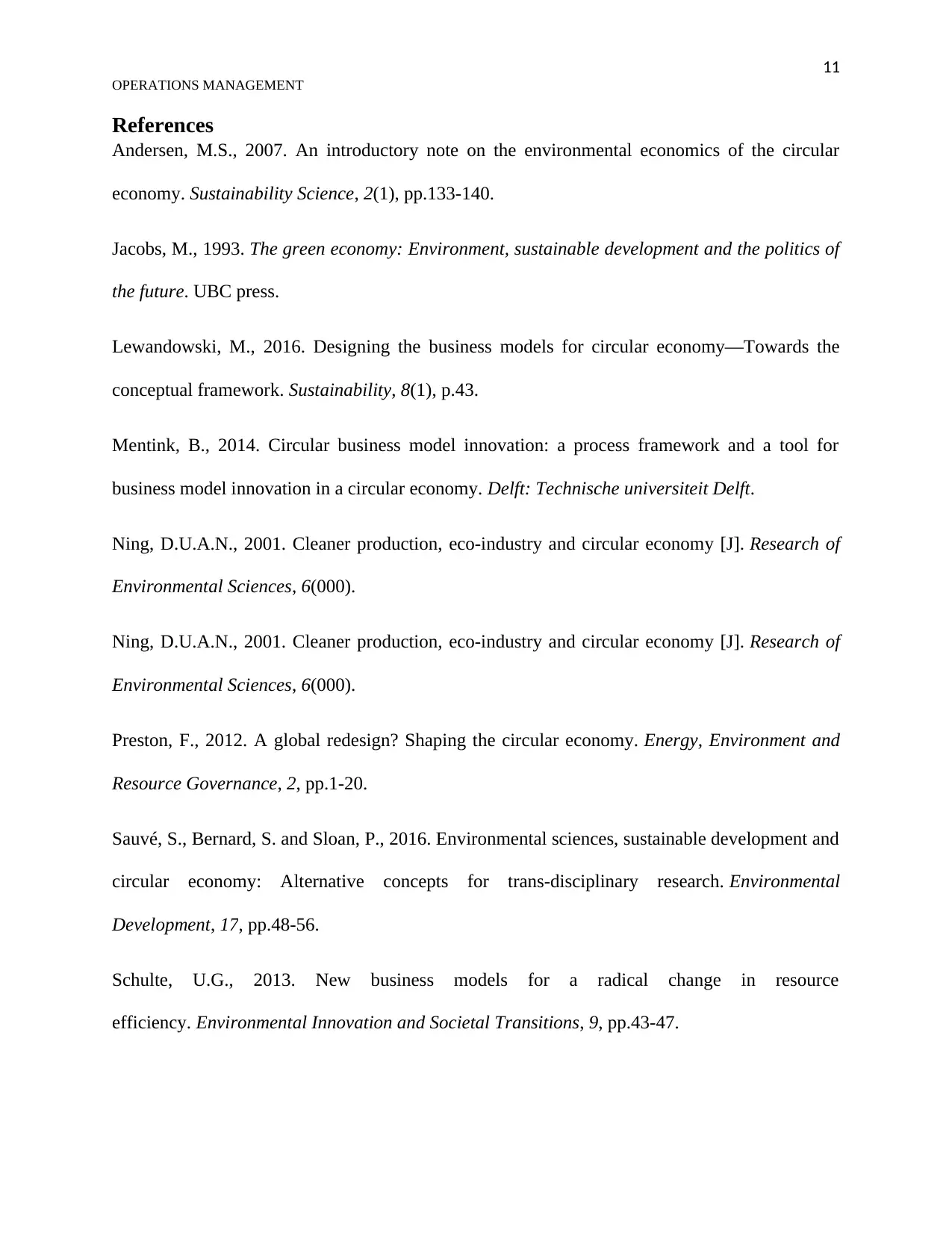
11
OPERATIONS MANAGEMENT
References
Andersen, M.S., 2007. An introductory note on the environmental economics of the circular
economy. Sustainability Science, 2(1), pp.133-140.
Jacobs, M., 1993. The green economy: Environment, sustainable development and the politics of
the future. UBC press.
Lewandowski, M., 2016. Designing the business models for circular economy—Towards the
conceptual framework. Sustainability, 8(1), p.43.
Mentink, B., 2014. Circular business model innovation: a process framework and a tool for
business model innovation in a circular economy. Delft: Technische universiteit Delft.
Ning, D.U.A.N., 2001. Cleaner production, eco-industry and circular economy [J]. Research of
Environmental Sciences, 6(000).
Ning, D.U.A.N., 2001. Cleaner production, eco-industry and circular economy [J]. Research of
Environmental Sciences, 6(000).
Preston, F., 2012. A global redesign? Shaping the circular economy. Energy, Environment and
Resource Governance, 2, pp.1-20.
Sauvé, S., Bernard, S. and Sloan, P., 2016. Environmental sciences, sustainable development and
circular economy: Alternative concepts for trans-disciplinary research. Environmental
Development, 17, pp.48-56.
Schulte, U.G., 2013. New business models for a radical change in resource
efficiency. Environmental Innovation and Societal Transitions, 9, pp.43-47.
OPERATIONS MANAGEMENT
References
Andersen, M.S., 2007. An introductory note on the environmental economics of the circular
economy. Sustainability Science, 2(1), pp.133-140.
Jacobs, M., 1993. The green economy: Environment, sustainable development and the politics of
the future. UBC press.
Lewandowski, M., 2016. Designing the business models for circular economy—Towards the
conceptual framework. Sustainability, 8(1), p.43.
Mentink, B., 2014. Circular business model innovation: a process framework and a tool for
business model innovation in a circular economy. Delft: Technische universiteit Delft.
Ning, D.U.A.N., 2001. Cleaner production, eco-industry and circular economy [J]. Research of
Environmental Sciences, 6(000).
Ning, D.U.A.N., 2001. Cleaner production, eco-industry and circular economy [J]. Research of
Environmental Sciences, 6(000).
Preston, F., 2012. A global redesign? Shaping the circular economy. Energy, Environment and
Resource Governance, 2, pp.1-20.
Sauvé, S., Bernard, S. and Sloan, P., 2016. Environmental sciences, sustainable development and
circular economy: Alternative concepts for trans-disciplinary research. Environmental
Development, 17, pp.48-56.
Schulte, U.G., 2013. New business models for a radical change in resource
efficiency. Environmental Innovation and Societal Transitions, 9, pp.43-47.
⊘ This is a preview!⊘
Do you want full access?
Subscribe today to unlock all pages.

Trusted by 1+ million students worldwide
1 out of 13
Related Documents
Your All-in-One AI-Powered Toolkit for Academic Success.
+13062052269
info@desklib.com
Available 24*7 on WhatsApp / Email
![[object Object]](/_next/static/media/star-bottom.7253800d.svg)
Unlock your academic potential
Copyright © 2020–2025 A2Z Services. All Rights Reserved. Developed and managed by ZUCOL.





